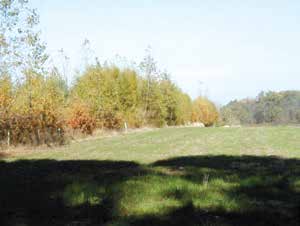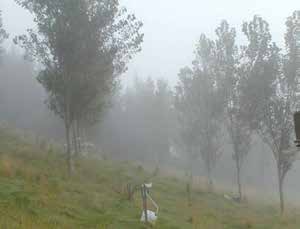chAPter 14 reduCing erosion and runoFF
effective when dealing with steep erodible lands, how-
ever, and also does not reduce tillage erosion.
There are a number of other practices that do little
to reduce runoff and erosion or build soil health but can
decrease channel erosion and sediment losses. Filter
strips remove sediment and nutrients before runoff
water enters ditches and streams (figure 14.9). Sediment
control basins have been constructed in many agricul-
tural regions to allow sediment to settle before stream
water is further discharged; they are often used in areas
where conventional soil management systems still gen-
erate a lot of erosion (figure 14.10).
Figure 14.9. Edge-of-field filter strips control sediment losses to streams.
Wind erosion is reduced by most of the same
Photo courtesy of USDA-NRCS.
practices that control water erosion by keeping the soil
across slopes to divert water across the slope to a
covered and increasing aggregation: reduced tillage or
waterway or pond (figure 14.7). Their primary purpose is
to channel water from upslope areas away and prevent
Figure 14.10. Top: A sediment control basin in a Central European
the downslope accumulation of runoff water that would
landscape where conventional tillage is widely used. Bottom: Sediment
regularly fills the basin and needs to be dredged.
then generate increased scouring and gullies.
Grassed waterways are field water channels that
reduce scouring in areas where runoff water accumu-
lates; they also help prevent surface water pollution
by filtering sediments out of runoff (figure 14.8). They
require only small areas to be taken out of production
and are used extensively in the midwestern U.S. grain
belt region, where long gentle slopes are common.
Terracing soil in hilly regions is an expensive and
labor-intensive practice, but it is also one that results in a
more gradual slope and reduced erosion. Well-constructed
and maintained structures can last a long time. Most ter-
races have been built with significant cost-sharing from
government soil conservation programs prior to the wide-
spread adoption of no-tillage and cover cropping systems.
Tilling and planting along the contour is a simple
practice that helps control erosion. When you work
along the contour, instead of up- and downslope, wheel
tracks and depressions caused by the plow, harrow, or
planter will retain runoff water in small puddles and
allow it to slowly infiltrate. This approach is not very
159
Building SoilS for Better CropS: SuStainaBle Soil ManageMent







